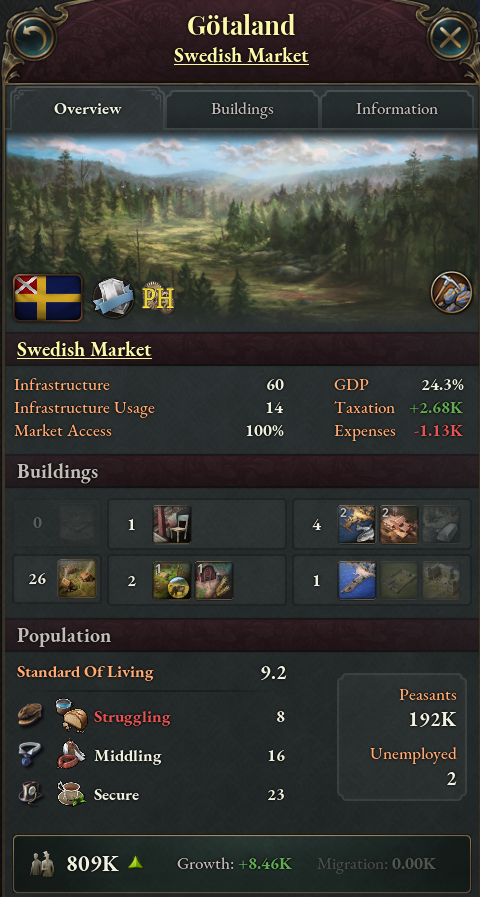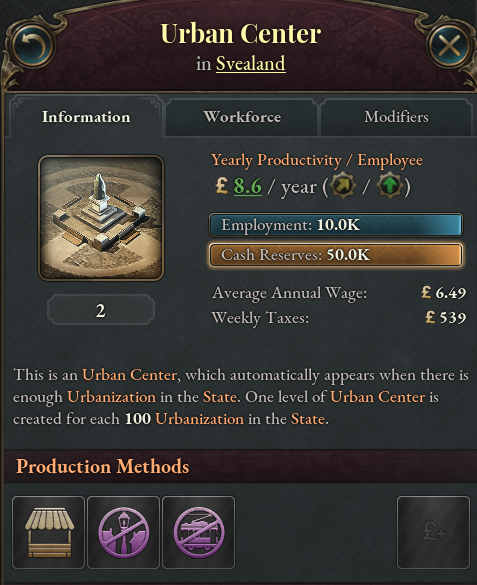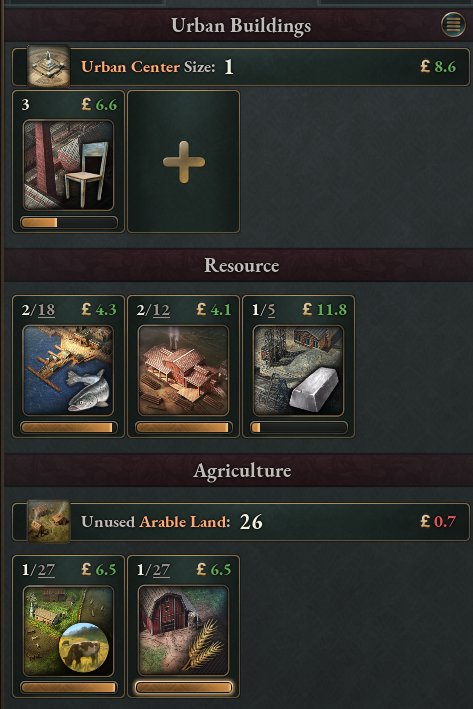So apparently, Canada is going to be "playable" from game start. That is the colonies that formed the Confederation are playable at game start. Which sounds pretty good to me, I can only hope they continue on this path and maybe allow for Boers to be playable without ahistorical starts for Transvaal and Oranje.
You are using an out of date browser. It may not display this or other websites correctly.
You should upgrade or use an alternative browser.
You should upgrade or use an alternative browser.
PC Gaming Victoria 3 Announced
- Thread starter Navarro
- Start date
More options
Who Replied?
PDXCon Victoria 3 Panels
Dev Diary 1
Navarro
Well-known member
Victoria 3 - Dev Diary #1 - Pops
Hello everyone! I’m Mikael, Victoria 3’s lead game designer - and oh boy does it feel good to finally be able to say that out loud! Today I have the pleasure to reveal some details about that one feature everyone thinks about when they hear...
Hello everyone! I’m Mikael, Victoria 3’s lead game designer - and oh boy does it feel good to finally be able to say that out loud! Today I have the pleasure to reveal some details about that one feature everyone thinks about when they hear “Victoria” - the Pops.
Pops were introduced in the very first Victoria game to represent your country’s population. Pop mechanics have since snuck into other Paradox titles like Stellaris and Imperator. But this in-depth population simulation is what Victoria is about, and we’re going to bring you a system with more depth than ever before!
In Victoria 3, Pops are the country’s engine - they work the industries, they pay the taxes, they operate the government institutions, and they fight the wars. They’re born, they die, they change occupation, they migrate. And they organize, get angry, and start revolutions.
Every Pop is visualized so you can see which demographic sports the best moustache. Note that Pop portraits are very much a work in progress!
You, the player, might be in charge of the country, but you’re not in charge of the Pops and can’t manipulate them directly. Yet everything you do to the country affects them, and they in turn will react in what they perceive to be their own best interests. A large part of your game will consist of trying to sate your population’s appetites for material goods or political reform. But most actions you will take aren’t to the benefit of every Pop in your nation, and by making life better for one part of the population you may inadvertently upset another demographic.
The most important aspect of Pops are their Professions, which reflects the types of jobs it carries out in the building where they work. A Pop’s profession determines its social class and can affect its wages, political strength, what other professions it might qualify for, and particularly which political Interest Groups it’s prone to supporting (which you will hear lots more about in future Dev Diaries.) Some of the Pop professions you will encounter in Victoria 3 are Aristocrats, Capitalists, Bureaucrats, Officers, Shopkeepers, Machinists, Laborers, and Peasants. Investing in industries that provide job opportunities for the kinds of professions you want to encourage in your country is key to the “society building” gameplay of Victoria 3.
Every variation of Profession, Culture, Religion, and Workplace in the world gets its own unique Pop. At any given time this results in many tens of thousands of Pops in the world working, migrating, procreating, and agitating.
The people that make up a Pop are distinguished into Workforce and Dependents. Members of the Workforce keep the buildings in the game operational and collect a wage from them in return. Those who cannot or aren’t permitted to be officially employed are considered Dependents. They collect only a small income from odd jobs and government programs.
Laws affect who is included in each category. At game start most countries do not accept women working and collecting a wage outside the home but by reforming laws governing the rights of women more Dependent Pops will enter the Workforce over time. By abolishing child labor, the amount of income Dependents bring home will decrease but will make it easier to educate your populace, increasing their overall Literacy. After a bloody war many Dependents of soldiers may be left without sufficient income, and you may decide to institute pensions to help your population recover.
In short: nothing in your country runs without Pops, and everything about your country affects those Pops, who in turn provide new opportunities and challenges during your tumultuous journey through the Victorian era and beyond.
I have oh so much more to say, but that is all for this week! You will hear much more from me in future Dev Diaries. Next week Martin will return to explain something quite central to the game - Capacities!
ParadiseLost
Well-known member
We better be able to mass-enslave children to work in factories. Its not a Paradox game if I can't commit crimes against humanity!
ParadiseLost
Well-known member
Child labour is modelled IIRC.
I know it is. I'm wondered if we can keep it and make it even more extreme. Like, slavery is still around when Victoria 3 starts. Can we keep it?
Are there dependent slave pops?
The possibilities are limitless!
Dev Diary #2
Navarro
Well-known member
Victoria 3 - Dev Diary #2 - Capacities
Hello and welcome back to another Victoria 3 dev diary! Today we will be talking about three of the four of the main ‘currencies’ of the game - namely Capacities (the last being Money, which we’ll of course come back to later). We mentioned in...
Hello and welcome back to another Victoria 3 dev diary! Today we will be talking about three of the four of the main ‘currencies’ of the game - namely Capacities (the last being Money, which we’ll of course come back to later).
We mentioned in the very first dev diary that there is no ‘mana’ in Victoria 3, and since this dev diary is about the game’s “currencies”, I want to be clear on what I mean by that. When we say there is “no mana” we mean that the resources in Victoria 3 arise and are spent in clearly defined ways that are parts of the simulation, not from an overly abstract concept or vague idea. There is, of course, some degree of abstraction involved (all games are abstractions after all), but we want all the game’s currencies to be strongly rooted in the mechanics and not feel arbitrary.
But enough about that and onto Capacities. What exactly are they?
Well, for starters, calling them currencies is actually not accurate. Capacities are not a pooled resource and are not accumulated or spent, but instead, have a constant generation and a constant usage (similar to for example Administrative Capacity in Stellaris), and you generally want to keep your usage from exceeding your generation. Each capacity represents one specific area of your nation’s ability to govern and is used solely for matters relating to that area.
As mentioned, Capacities are not accumulated, so excess generation is not pooled, but instead there is an effect for each Capacity which is positive if generation exceeds usage and quite negative if usage exceeds generation - a country that incorporates territories left and right without expanding its bureaucratic corps may quickly find itself mired in debt as tax collection collapses under the strain!
Bureaucracy represents a nation’s ability to govern, invest in and collect taxes from its incorporated territory. It is produced by the Government Administration building, where many of a nation’s Bureaucrats will be employed. All of a nation’s Incorporated States use a base amount of Bureaucracy which increases with the size of their population, and further increased by each Institution (such as Education or Police - more on those later!) that a country has invested in. Overall, the purpose of Bureaucracy is to ensure that there is a cost to ruling over, taxing and providing for your population - administrating China should not be cheap!

The Swedish Bureaucracy is currently a bit overworked and the country could certainly benefit from another Government Administration building or two.
Authority represents the Head of State’s personal power and ability to enact change in the country through decree. It is generated from your Laws - generally, the more repressive and authoritarian the country, the more Authority it will generate - and is used by a variety of actions such as enacting decrees in specific states, interacting with Interest Groups and promoting or banning certain types of Goods. Overall, the purpose of Authority is to create an interesting trade-off between more and less authoritarian societies - by shifting the distribution of power away from the Pops into the hands of the ruler, your ability to rule by decree is increased, and vice versa.

The Swedish King has more Authority at his disposal than he is currently using, slightly speeding up the rate at which laws can be passed.
Influence represents a country’s ability to conduct diplomacy and its reach on the global stage. It is generated primarily from your Rank (Great Powers have more Influence than Major Powers and so on) and is used to support ongoing diplomatic actions and pacts, such as Improving Relations, Alliances, Trade Deals, Subjects and so on. Overall, the purpose of Influence is to force players to make interesting choices about which foreign countries they want to build strong diplomatic relationships with.

Sweden has plenty of unused Influence and could certainly afford to support another diplomatic pact or two!
That’s all for today! Join us again next week as I cover something yet another topic that’s fundamental to Victoria 3: Buildings. See you then!
Thank the Lord, mana is gone. A blight on PDX gaming has passed.
Dev Diary #3
Navarro
Well-known member
Victoria 3 - Dev Diary #3 - Buildings
Hello again everyone! It’s Thursday again, and that means that it’s time to talk about Buildings. Buildings are a core mechanic of Victoria 3, as it is where the Pops work to produce resources such as Goods. Buildings represent a wide range of...
Hello again everyone! It’s Thursday again, and that means that it’s time to talk about Buildings. Buildings are a core mechanic of Victoria 3, as it is where the Pops work to produce resources such as Goods. Buildings represent a wide range of industries, businesses and government functions, from humble subsistence farms to complex motor industries and sprawling financial districts. In this dev diary, we’re going to broadly cover the main types of buildings and their function in Victoria 3.
To talk about buildings though, I first have to mention states! States are a concept that should be generally familiar to anyone who’s played some of our other games such as Victoria II or Hearts of Iron IV - a geographic unit of varying size in which much of Victoria 3’s gameplay takes place. States are where Pops live and (more importantly for our subject matter) where Buildings are located and built.

The State of Götaland in Sweden
We will return to states more in later dev diaries, but for now let’s keep talking about Buildings!
Before we start on Buildings, something that’s important to note is that Buildings are just places where Pops can work and generally do not represent a single building - a single level of Government Administration, for example, represents the necessary buildings and infrastructure to support a certain number of Bureaucrats. Buildings always need qualified pops to work in them to yield any benefit, and an empty building is just that - empty and completely useless. This holds true even for buildings like Railroads and Ports that did not need Pops to work in them in Victoria 2.
Most buildings are directly constructed, but some (like the Subsistence Buildings below) will appear automatically based on certain conditions. When Buildings are constructed, the construction uses Pop labor and goods, and the costs involved will be subject to market forces.
But onto the different building types! First out, we have Subsistence Buildings. These are a special type of highly inefficient Buildings that cannot manually be built or destroyed, but rather will appear anywhere in the world where there is Arable Land that isn’t being used for another type of building. The vast majority of the world’s population starts the game ‘working’ in subsistence buildings as Peasants, and much of the game’s industrialization process is about finding more productive employment for your Peasants.

Peasants eke out a meager living in these Subsistence Farms, contributing little to GDP and taxes per capita
Another special type of building is Urban Centers. Like Subsistence Buildings, these are automatically created rather than built, with the level of Urban Center in a State being tied to the amount of Urbanization generated by its other buildings. Urban Centers primarily employ Shopkeepers and provide a number of important local functions that we will get into at a later point.

The Urban Center is where you’ll find most of your middle-class Shopkeepers
Next up we have Government Buildings. These are buildings that are fully funded by the state (ie, you!) and provide crucial civil services required for the smooth running of a Victorian nation. Examples include Government Administrations where Bureaucrats produce Bureaucracy for the administration of incorporated states and funding of Institutions, and Universities where Academics produce Innovation for technological progression.

Bureaucrats work in Government Administrations to provide Bureaucracy - the lifeblood of the government
The counterpart to Government Buildings is Private Industries. The vast majority of Buildings in Victoria 3 fall under this category, which includes a broad range of industries such as (non-subsistence!) farms, plantations, mines and factories. Unlike Government Buildings, Private Industries are not owned by the state but rather by Pops such as Capitalists and Aristocrats, who reap the profits they bring in and pay wages to the other Pops working there (usually at least - under certain economic systems the ownership of buildings may be radically different!).
Many of these buildings are limited by locally available resources such as Arable Land for agriculture and simply how much iron is available in the state for Iron Mines. Urban Buildings such as Factories however, are only limited by how many people you can cram into the state, simulating the more densely populated nature of cities. In short, there is no system of building ‘slots’ or anything like that, as we want limitations on buildings to function in a sensible and realistic way.

Several different types of Private Industries are shown below
Finally there are Development Buildings. These are often (but not always!) government buildings that distinguish themselves by providing vital state-level functions. A couple examples are Barracks that recruit and train soldiers from the local population and Railways that provide the Infrastructure other buildings need to bring their goods to the Market.

From left to right: Barracks, Port, Naval Bases and Railway
To finish up this dev diary I just want to mention that building up your country is meant to be more of a hands-on experience in Victoria 3, as this is absolutely core to the society-building aspect of the game and forms a major part of the game’s core loop. This naturally also means that we need to give the player the necessary tools to manage their buildings in a large empire, which may involve some form of autonomous building construction, though we haven’t yet nailed down exactly what form that would take (and whether it will involve decision making on the part of the investor class). Ultimately though, we want the player, not the AI to be the one primarily in charge of the development of their own country.
Well, there you have it. There is of course a lot in here (such as Production Methods) that will receive further explanation in the many more dev diaries we have planned, so be sure to tune in next week as I talk about Goods. See you then!
Navarro
Well-known member
So apparently, Canada is going to be "playable" from game start. That is the colonies that formed the Confederation are playable at game start. Which sounds pretty good to me, I can only hope they continue on this path and maybe allow for Boers to be playable without ahistorical starts for Transvaal and Oranje.
Transvaal and Oranje do seem to be on the map at start.
Navarro
Well-known member
Wait, it is? What are the game start/end date?
Heh. It seems when you inevitably convert to HOI4 your nation will get some inexplicable deja vu.
"Why are we repeating a year?"
Arlos
Sad Monarchist
Heh. It seems when you inevitably convert to HOI4 your nation will get some inexplicable deja vu.
"Why are we repeating a year?"
I‘d have preferred if it laster longed in the other direction, but I guess it’s not bad!
I quite like the idea that Port and railway/infrastructure will now need pop to work, that mean you’ll have to balance out what you’re economy need, with what you’re population allow you to have, so huge countries like Sweden who have low population density will need to be played differently.
This also make me question how mobilisation will work even more.
Arlos
Sad Monarchist
True enough, It’s pretty easy to win everything as a player led GB before 1850, it just take a couples of wars and nobody can oppose you even into the late game.GB is a bit boring in Vicky 2, you're already on top of the world p. much.
Arlos
Sad Monarchist
That look incredibly complex for a railways system, nothing like Vic 2.New screen:

They even added revenues and number of locomotive.
fudge, please don’t get me so excited. 😆
Users who are viewing this thread
Total: 2 (members: 0, guests: 2)
